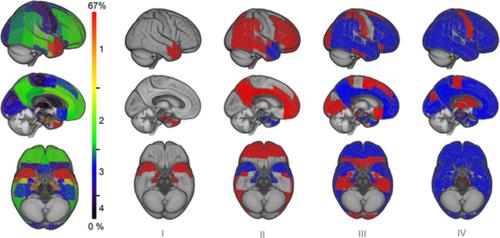当前位置:
X-MOL 学术
›
Hum. Brain Mapp.
›
论文详情
Our official English website, www.x-mol.net, welcomes your
feedback! (Note: you will need to create a separate account there.)
Longitudinal validity of PET-based staging of regional amyloid deposition.
Human Brain Mapping ( IF 3.5 ) Pub Date : 2020-07-10 , DOI: 10.1002/hbm.25121 Irina Jelistratova 1 , Stefan J Teipel 1, 2 , Michel J Grothe 1, 3
Human Brain Mapping ( IF 3.5 ) Pub Date : 2020-07-10 , DOI: 10.1002/hbm.25121 Irina Jelistratova 1 , Stefan J Teipel 1, 2 , Michel J Grothe 1, 3
Affiliation

|
Positron emission tomography (PET)‐based staging of regional amyloid deposition has recently emerged as a promising tool for sensitive detection and stratification of pathology progression in Alzheimer's Disease (AD). Here we present an updated methodological framework for PET‐based amyloid staging using region–specific amyloid‐positivity thresholds and assess its longitudinal validity using serial PET acquisitions. We defined region‐specific thresholds of amyloid‐positivity based on Florbetapir‐PET data of 13 young healthy individuals (age ≤ 45y), applied these thresholds to Florbetapir‐PET data of 179 cognitively normal older individuals to estimate a regional amyloid staging model, and tested this model in a larger sample of patients with mild cognitive impairment (N = 403) and AD dementia (N = 85). 2‐year follow‐up Florbetapir‐PET scans from a subset of this sample (N = 436) were used to assess the longitudinal validity of the cross‐sectional model based on individual stage transitions and data‐driven longitudinal trajectory modeling. Results show a remarkable congruence between cross‐sectionally estimated and longitudinally modeled trajectories of amyloid accumulation, beginning in anterior temporal areas, followed by frontal and medial parietal areas, the remaining associative neocortex, and finally primary sensory‐motor areas and subcortical regions. Over 98% of individual amyloid deposition profiles and longitudinal stage transitions adhered to this staging scheme of regional pathology progression, which was further supported by corresponding changes in cerebrospinal fluid biomarkers. In conclusion, we provide a methodological refinement and longitudinal validation of PET‐based staging of regional amyloid accumulation, which may help improving early detection and in‐vivo stratification of pathologic disease progression in AD.
中文翻译:

基于 PET 的区域淀粉样蛋白沉积分期的纵向有效性。
基于正电子发射断层扫描 (PET) 的区域淀粉样蛋白沉积分期最近已成为阿尔茨海默病 (AD) 病理进展的灵敏检测和分层的有前途的工具。在这里,我们提出了一个使用区域特异性淀粉样蛋白阳性阈值的基于 PET 的淀粉样蛋白分期的更新方法框架,并使用连续 PET 采集评估其纵向有效性。我们根据 13 名年轻健康个体(年龄 ≤ 45 岁)的 Florbetapir-PET 数据定义了特定区域的淀粉样蛋白阳性阈值,并将这些阈值应用于 179 名认知正常的老年人的 Florbetapir-PET 数据,以估计区域淀粉样蛋白分期模型,以及在更大样本的轻度认知障碍(N = 403)和 AD 痴呆(N= 85)。对该样本的一个子集进行 2 年随访 Florbetapir-PET 扫描(N= 436) 用于评估基于各个阶段过渡和数据驱动的纵向轨迹建模的横截面模型的纵向有效性。结果表明,淀粉样蛋白积累的横断面估计和纵向建模轨迹之间存在显着一致性,从前颞区开始,然后是额叶和内侧顶叶区,剩余的关联新皮层,最后是初级感觉运动区和皮层下区。超过 98% 的个体淀粉样蛋白沉积分布和纵向阶段转变遵循这种区域病理进展的分期方案,脑脊液生物标志物的相应变化进一步支持了这一方案。综上所述,
更新日期:2020-07-10
中文翻译:

基于 PET 的区域淀粉样蛋白沉积分期的纵向有效性。
基于正电子发射断层扫描 (PET) 的区域淀粉样蛋白沉积分期最近已成为阿尔茨海默病 (AD) 病理进展的灵敏检测和分层的有前途的工具。在这里,我们提出了一个使用区域特异性淀粉样蛋白阳性阈值的基于 PET 的淀粉样蛋白分期的更新方法框架,并使用连续 PET 采集评估其纵向有效性。我们根据 13 名年轻健康个体(年龄 ≤ 45 岁)的 Florbetapir-PET 数据定义了特定区域的淀粉样蛋白阳性阈值,并将这些阈值应用于 179 名认知正常的老年人的 Florbetapir-PET 数据,以估计区域淀粉样蛋白分期模型,以及在更大样本的轻度认知障碍(N = 403)和 AD 痴呆(N= 85)。对该样本的一个子集进行 2 年随访 Florbetapir-PET 扫描(N= 436) 用于评估基于各个阶段过渡和数据驱动的纵向轨迹建模的横截面模型的纵向有效性。结果表明,淀粉样蛋白积累的横断面估计和纵向建模轨迹之间存在显着一致性,从前颞区开始,然后是额叶和内侧顶叶区,剩余的关联新皮层,最后是初级感觉运动区和皮层下区。超过 98% 的个体淀粉样蛋白沉积分布和纵向阶段转变遵循这种区域病理进展的分期方案,脑脊液生物标志物的相应变化进一步支持了这一方案。综上所述,











































 京公网安备 11010802027423号
京公网安备 11010802027423号